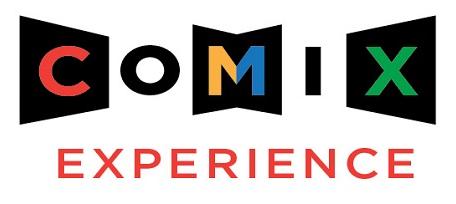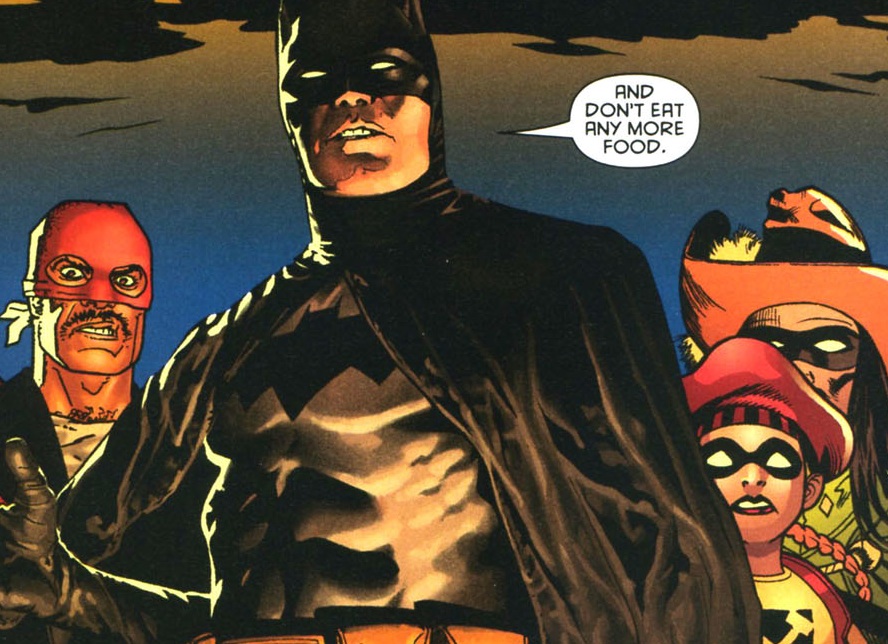 Greetings, children of the cosmos! Today's column is going to cover one of my favorite topics: mind-expansion.
Greetings, children of the cosmos! Today's column is going to cover one of my favorite topics: mind-expansion.
And I can think of no better way for us to start off than expanding our minds away from comics, and toward the filmic arts. It’s a natural progression, really; as widespread media coverage of the San Diego fiesta teaches us year in and year out, the true excitement in comics is actually excitement in movies, whether through direct adaptations of comics, or maybe just general ‘geek-friendly’ pictures, which are apparently just as good. Now, I may not have actually watched any of those things since Superman Returns and its concluding three reels of people weeping into their shirtsleeves, but I do know what side my bread of anticipation ought to be buttered on!
Oh, but I think I may have unwittingly revealed my tragic secret, folks. The thrill is gone for me, personally. I mean, the announcement of a new comic-book movie used to have my hairs standing on end. The two-fisted gallantry of Ghost World, the blood and thunder of American Splendor - I couldn’t wait to burst into the theater lobby cosplaying as Joyce Brabner. But these days, mere adaptations just don’t get my ass into a nine-dollar seat. Iron Man? The Dark Knight? In the Valley of Elah? Feh. Wake me when someone’s got Bratpack up on the screen. These days, I need something stronger to get me perked up. Like, say, a more potent fusion of funnybook something-or-other and movie-like presentation or thereabouts.
Yep, what really does it for me these days, is comic-book creators actually making movies themselves.
My anticipation for The Spirit is running wild, of course. But, you know, I kind of like these things better on a shoestring. No big money. No heavyweight movie talents. Just a person from one medium venturing out there and getting things done in another. For example, there’s Mike Allred’s 1996 feature Astroesque, the film layer of his multimedia Red Rocket 7 project of the time. I don’t know if you’ve seen Astroesque; it’s on a dvd with the Christopher Coppola-helmed Allred adaptation G-Men From Hell, and it’s mostly footage of Mike Allred running away from (or perhaps toward) people in a ditch, with extra added fart jokes and guitar strumming. I can’t even look at Madman Atomic Comics today without thinking “that Mike Allred guy sure knows how to run.” It’s 100% true.
Or how about Sam Kieth’s 2000 feature Take It to the Limit, which I believe originated as a horror project for Roger Corman, and ultimately ended up as a family-friendly rock-climbing movie? Hell, let’s not even be recent; the IMDB denies this exists, but Neal Adams totally directed a 1987 kiddie flick titled Death to the Pee Wee Squad, starring his kids Jason and Zeea (take that, Robert Rodriguez), and no less than Troma Entertainment has a poster to prove it. Haven’t seen that one.
Now, you may have picked up on a slightly facetious tone thus far. But I genuinely do admire these attempts to make films -- complicated, troublesome, life-shortening things they are -- with little money and maximum enthusiasm. And I do think it’s fascinating to watch seasoned comics professionals branch out into this rocky territory.
But the most fascinating one I’ve seen hails from 2005, and it doesn’t even resemble a movie so much as episodes from a public broadcast show gone incurably mad. Yet it's funny, and surprising, and altogether recommended. Directed and written and starring and partially scored by none other than the great Gilbert Hernandez. You’ve heard of Hernandez, I’m sure. As co-creator of Love and Rockets and a general comics legend, Beto needs no introduction, yet it’s worth noting a few things about his body of work for our purposes.
While best known for his tales of the Latin American village Palomar, Hernandez has explored many varied genres and subject matters. His comics reflect a great appreciation for soap opera, fantasy, sex, and various species of low-budget film. Sometimes his works mix and match tropes to the point of tonal incoherency; his 1996 Dark Horse miniseries Girl Crazy veered from cheesecake superhero spoof to gore-spattered will-to-power fable without ever slowing down. He also has a love for intuition and improvisation, which sometimes leads him down odd paths; while somewhat underrated, his 2002 Vertigo miniseries Grip: The Strange World of Men did wind up spending an awful lot of space bending over itself with flashbacks for the purposes of explaining things the reader has been shown. But, at his best, all of these elements combine to form comics of uncanny poise and worldview, all of it transmitted through his often stunning command of the primal elements of the page, the viewpoints and the location transitions and that beautiful illusion of movement. Few do it better.
Most of these elements are also at work in The Naked Cosmos, Beto's grand foray into shooting actors and scenes with a video camera. I can't quite call it a movie, since it's structured like a quartet of episodes of a television program. Indeed, some sources claim that these episodes actually aired on public access television in the Las Vegas area, although my own searches indicate that this is merely the concept behind the work, a simulation of various episodes that actually builds and climaxes as a singular thing. Regardless of what it is, rest assured that it's very funny, very eccentric, and prone to lapsing into wonderfully jarring zones of melancholy and violence. From a filmmaking standpoint, it certainly represents a level of forethought as to how to cope with the project's obvious monetary limitations. Hell, a strange television show needs to look low-budget, and director/writer/star Hernandez more than rises to the challenge.
Also, by 'star,' I actually mean 'performer of all adult male roles.' Yep, Beto plays a whole lot of characters in this thing, and his wife, Carol Kovinick, plays nearly all the rest (so, all adult female roles). Daughter Natalia Beatriz Hernandez plays all children, regardless of gender. There's also exactly one scene in which Beto shares the screen with another male character, his face obscured. I have unilaterially decided that this is Mario Hernandez, although I have no proof to back that up, nor do I actually know what Mario Hernandez looks like.
The plot concerns a fellow named Quintas (an effeminate, black-garbed Hernandez with lipstick, eyeshadow and a blonde wig), who's the host of the show we're watching - The Naked Cosmos. Quintas only wants to urge his viewers, the children of the cosmos, to harmonize with the astral plane and stuff like that. He's very weird, and somehow sad, prone to pondering the existence of a mysterious purple disc that seems to take everyone away for fun and memorable rides except for him. Sometimes he needs an injection, which momentarily causes his facial veins to pop and foam to pour from his mouth. Beto completely freaks out with the character at least twice per episode, including several episode-closing exhortations to look to the skies, howled at the top of his lungs.
Quintas also wants to have an entertaining show, but he's often interrupted, especially by Kalisto (Hernandez with a thin felt mustache, a Zorro mask, and a purple cloth around his head), his clone, and the rational, scientific blowhard yang to his spacey, gentle yin. Catchphrase: "You have the mind... OF A CHILD!!" Both clones pine for Mistress Velda (Kovinick in a blonde beehive), a perky researcher of some sort, and both seem to answer to the Chief (Kovinick wearing a leopard mask and speaking only Spanish), for seemingly little reason. Rounding out the cast is Ego (Hernandez in a long blonde good ol' boy wig with a shaggy mustache), who has the power of teleportation, Mr. Mims (Hernandez with glasses, in hyper-nerd overdrive), the show's meek aide, and Zansky (Hernandez standing upside down with his face pressed through a black screen, with little eyes and glasses and hair pasted to his chin), a naughty Ninth Dimensional entity who introduces educational film clips that are actually random bits of various public domain movies pasted together.
Basically, each 'episode' consists of bizarre sketches and routines, broken apart by still details from some astrological map, and that old public tv standby of footage of high-tech equipment set to spooky space music. Most scenes take place in front of a simple background, although sometimes characters wander out into the desert, and occasionally there's a special bit like the aforementioned films or a runtime-padding exploitation-style travelogue scene set to narration (the setting: Las Vegas, of course!). The humor is deeply, deeply odd, and only rendered more surreal by Hernandez's wildly devoted performance(s), joyfully blurring the line between a character in a show nervously reading off of cue cards and Gilbert Hernandez reading his character's lines off of cue cards, although sometimes he seems to be making his lines up as he goes along. There's even a bit where Quintas narrates a story, which is visually depicted via Gilbert Hernandez drawings.
It's actually quite tempting to draw parallels between this madness and Beto's comics work. There's plenty of comics references, including some sanctum sanctorum dialogue and a scene where Quintas reads a copy of Amazing Adult Fantasy #11. But even Hernandez's structural approach to the film, small half-scenes breaking off into different ones in different locations that eventually add up to a cumulative impact rather than a directly narrative one, are reminiscent of some of his page layouts as of late, with bits and burbles of talk snapping off, the reader's eye careening from location to location (I found the Beto bits from the new Love and Rockets #20 to embody this style nicely). Granted, Beto also layers his film with an added coat of concept, it being a type of formulaic television program, but the likenesses are still interesting.
Hernandez also includes a full-length 20-page comic book with the dvd, for even easier comparison, but he opts to use that forum to fill in the lives of the characters outside of the show, melding the tragic(!) saga of Quintas and Kalisto into a two-fisted, blood-spattered superhero epic, complete with a double-page center splash of war against a horde of mutants. It both serves as prelude to and summary of the actual film, in that Quintas' and Kalisto's rivalry ultimately leads to a (literally) show-stopping battle in the desert, Gilbert Hernandez flailing madly in two costumes at an off-camera opponent as the visuals cut from Quintas to Kalisto to Quintas to Kalisto. Needless to say, only the innocents are hurt when opposing forces of the human condition meet, leading to a burning action figure and Gilbert's many characters flailing in sadness before vast desert vistas, as if the latest episode of Jack Horkheimer's Star Hustler has ended with Jack shooting a man while looking him in the eye and lamenting before his video background.
It's bananas. Yet, it's a wholly Gilbert Hernandez type of bananas. Honestly, this may be one of the most emphatic translations I've seen of a comics artist's 'feel' from sequential art to another medium. Consider my head in the stars! You can still order this dvd (region-free, though NTSC) from Bright Red Rocket, its publisher, and I think Beto's admirers will probably enjoy it. Hell, you might enjoy it if you just enjoy weird stuff, like a comics legend prancing around in silly costumes and bugging his eyes out at everything. Part of the joy of culture, I think.












